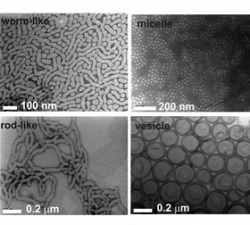 |
| Differently shaped nanoparticles have different properties when infiltrating cancer cells.--Courtesy of UNSW |
Often when using nanoparticles to target and penetrate cancer cells, the shape of the tiny drug-carrying vehicles is crucial to their performance. And Australian researchers have found evidence that "worm-shaped" nanoparticles may be more effective than spheres at delivering cancer drugs to breast cancer.
The scientists at the University of New South Wales (UNSW) published a study in the journal Polymer Chemistry that demonstrated cylindrical-shaped nanoparticles performing 7 times better than those of other shapes, including spherical micelle, cylindrical micelle and vesicles. They concluded that the shape plays an important role in how much of a drug is taken in by cancer cells and how effective those drugs are once they get there.
"What we've discovered is that a different shaped nanoparticle can have a very different effect on cancer cells, even with the same amount of drug," said co-leader Cyrille Boyer of UNSW in a statement. "However there is still a lot of work to do and we need to test the nanoparticles in vitro with a range of cancer cells."
It's not the first study to investigate the best nanoparticle shape for drug delivery, though. In October, Georgia Tech researchers found that disc-shaped particles were best at gaining entry into human cells. And a study from the University of California in Santa Barbara found in June that a rod shape helped nanoparticles adhere to blood vessels in the lung and the brain.
Along with the research on breast cancer, the UNSW scientists are looking at the best shape for other types of cancer, as well as a more efficient way of producing the worm-shaped vehicles en masse.
- here's the UNSW report
- and the Polymer Chemistry abstract